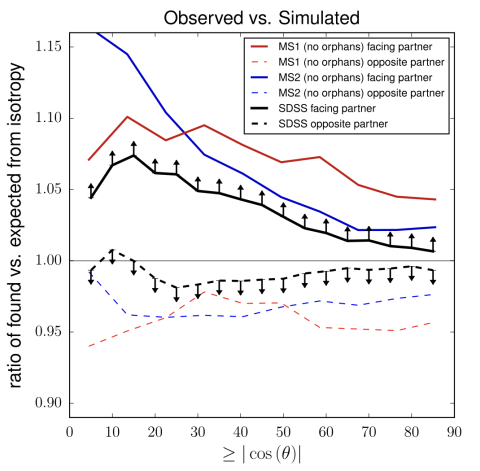
Comparison of the angular distribution of satellites galaxies around paired host galaxies between systems observed in SDSS (black) and two cosmological simulations based on the Lambda Cold Dark Matter Model (red and blue).
My newest article (with Rodrigo Ibata and James Bullock), titled “The Lopsidedness of Satellite Galaxy Systems in ΛCDM Simulations“, has now been published by the Astrophysical Journal. It was motivated by a study by Libeskind et al. (2016) in which they discovered a significant preference of satellite galaxies to lie on the side towards a nearby partner galaxy of their host. For this, Libeskind et al. identified nearby pairs of Milky-Way-like galaxies in the SDSS survey, and then measured the angular distribution of their satellite galaxies relative to the line connecting each pair. After stacking the data of thousands of such pairs, they found that there is up to an 8% excess of satellites in the region pointing to the partner galaxy (black line in the figure). This can be considered a lower limit of the true “lopsidedness” because the satellite galaxy sample is most likely contaminated by more randomly distributed fore- and background galaxies. In my new paper, I performed the first-ever comparison of this observed effect with expectations from cosmological simulations.
Specifically, I repeated the observational study on several cosmological simulations: the dark-matter-only Millennium-I (red in the figure), Millennium-II (blue in the figure), and ELVIS simulations, as well as the hydrodynamical Illustris simulation. I find that a similar, and in fact somewhat stronger, signal of lopsidedness of satellite galaxies is expected in ΛCDM, such that the effect does not seem to pose a threat to the standard model of cosmology. This is maybe a bit surprising, given the strong tension the distribution of satellite galaxies in planes of satellites poses for the model. Unfortunately, the statistics of the Illustris simulation are insufficient to judge whether the effect persists, or is in- or decreased, if the cosmological simulations include baryonic physics. This, as well as a more detailed investigation of the origin of the lopsidedness and its possible connection to environmental effects, satellite galaxy accretion patterns, and filaments of the cosmic web connecting paired host galaxies will be a natural continuation of this research. It is, however, already interesting to see that not all phase-space structures we see in satellite galaxy systems are in conflict with ΛCDM expectations.
Here’s a twitter thread providing some more explanations of the new study:
New paper: “The Lopsidedness of Satellite Galaxy Systems in ΛCDM simulations”, with R. Ibata & @jbprime https://t.co/JaLQnFLKMk pic.twitter.com/Yvxzhc8V1U
— Marcel S. Pawlowski (@8minutesold) October 24, 2017
